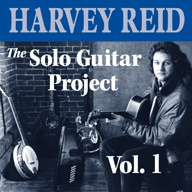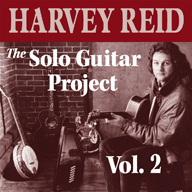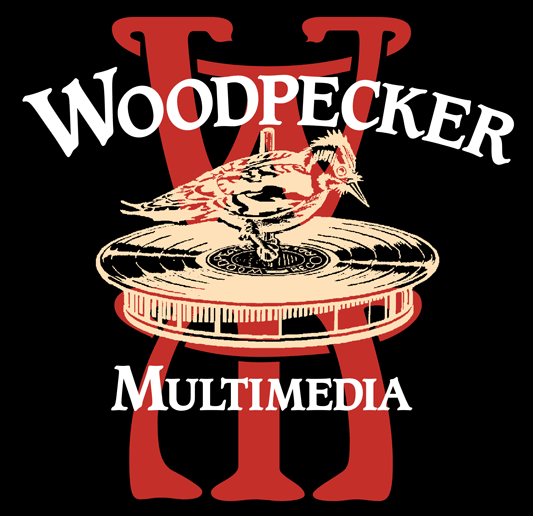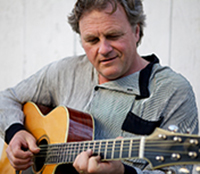The Solo Guitar Project is
a 2-volume collection of Harvey Reid's best solo guitar work from his back catalog of recordings, finally in one
place that is universally accessible. This is some of the best recorded guitar work he has ever done, it is one of the
things he is most known for, and needed to be where people can easily access it.
Reid has only made only 3 solo guitar recordings
out of the 22 projects he released between 1982 and 2009, and the 2nd of those guitar albums was largely a remake
of the first, an LP that has been out of print since 1990. The guitar CD's have sold better than his other
recordings, but because he is also fond of the mandolin, autoharp and banjo, and of songs, a lot of other great
guitar pieces he has released over the years have been scattered among his other
recordings, and generally not heard by guitar fans. The Solo
Guitar Project contains pieces from 7 earlier recordings, and before April 2010 none of its tracks has
been available for sale as a digital download. All the tracks were recorded live in the studio with only a single
guitar, except the Woodchopper's
Hornpipe/Jimmy in the Swamp which features David Surette playing some rhythm guitar behind Harvey's flatpicking.
In addition to collecting and assembling these pieces, Reid
has also done some serious re-mastering of the original recordings, which has made a dramatic improvement.
When he began recording digitally in 1988, the appeal of the digital was that 1) there was little or no background
hiss, flutter or other noise 2) tape was cheap and 3) copies of recordings were identical to the originals. At
the beginning, digital recording offered a chance to capture music "alive" more effectively than analog,
because it could handle a much wider dynamic range, and there was no tape noise. (Here is a much longer
piece Reid wrote explaining remastering...)
Here is the short explanation: Reid says:
" Unfortunately, over the last 25 years, recorded music has gone through a little-understood revolution, and
as a result, most music recorded today is louder but has less dynamic range than music recorded between roughly
1955 and 1995. Those artists who sought to increase the authenticity of the recording experience by using digital
media found themselves overwhelmed by this new trend. By a process known as "compression" (
more correctly called "limiting")
the loudest parts of the music (usually called "peaks" or "spikes" in recording lingo) can
be squashed down, which means that the overall volume of the track can be increased. The more you remove the dynamic
range and the peaks of a recording, the louder it can be made to sound before the volume meters "red line." If
you listen carefully to pop music of today, whispering and shouting are the same volume. Those of us who used early
digital recording to try to capture our muic "alive" found that our recordings were literally drowned out by the
heavily-compressed music that has followed."
"It was probably the multi-CD changer that brought this
on, and my early digital recordings from the late 1980's and early 1990's sound dramatically quieter (about 8db
on average) overall than almost any other CD's, except of course other recordings from that era of things like
classical music that also sought to take advantages of the properties of digital recording. So one of the things
I did was to make my Solo Guitar Project tracks more in line with the overall volume level of
modern recorded acoustic music. This makes the music easier to listen to, especially in background situations
like a restaurant, or in a car where the road noise drowns out the quiter parts of the music. Those of you who
are familiar with my older recordings will notice that the quieter tracks now have a presence they never had
before."
"The other thing I did in the remastering was to work from
the original raw digital tape recordings (which I managed to locate with some careful searching and some luck)
and to do some fine tuning of the sound with the now-impressive toolbox of digital music tools that are now available.
Early digital music was almost a "closed box," and
what we now take for granted in terms of having access to every aspect of the wave forms in the computer did not
exist in 1989. I did almost all of my recording with stereo miking techniques involving two mikes, and it turns out
that by doing some very subtle adjustments in the left-right "panning" balance and also of the time delay
between the two mike signals, the guitar could often be made to sound much more rich, musical and "present." It
is not unlike adjusting a pair of binoculars to bring things into better focus. Some careful EQ (tone adjustment)
was done and digital noise removal tools were also deployed to take out a few chair squeaks and other un-musical
noises that have bugged me for years. Some more sophisticated reverb and digital dithering were also used. All these
subtle improvements have combined to make the remastered tracks sound quite a bit better to my ears than they have
ever sounded in the past.
I thought that after 20 years of hearing them the "old
way" that
I might not like the new sound, but the results were instantly apparent to me. The improved sound jumped out
at me right away, even in the car as I drove home from the mastering session. I don't anticipate any complaints from
fans, but I do still have some original, un-improved CD's you can buy of almost all of my back catalog. Feel
free to try to talk me into pressing some CD's of this project also. I am considering making a limited pressing
as a 2-CD set."
18 more tracks of Reid's solo guitar music titled "Capo Voodoo: Solo Guitar" (all using a partial capo) is now available, and 2 albums of songs
will appear in 2011 Like Capo Voodoo: Solo Guitar, they will include
some unreleased tracks as well as remastered things from earlier recordings. |
VOLUME 1  
1- Racing the Storm (H. Reid) [114]
2- Amazing Grace/What a Friend/Swing Low (Trad.) [105]
3- Prelude in Dm (JS Bach) [105]
4- Canal Street Strut (H. Reid) [105]
5- Uncloudy Day (Trad.) [114]
6- Cindy/Cripple Creek (Trad.) [105]
7- Scotland Suite 1: Requiem (H. Reid) [114]
8- Pegasus (H. Reid) [114]
9- The French Quarter Concerto (H. Reid) [114]
10- Flüf's Vacation (H. Reid) [114]
11- Archibald MacDonald of Keppoch (Trad.) [103]
12- Dirty Dish Rag (H. Reid) [105]

LISTEN / BUY ONLINE
Read the liner notes to Volume 1
VOLUME 2  
1- Star Island Jig (H. Reid)
2- Magnolia Promenade (H. Reid) [113]
3- Norway Suite 1: The Waterfall (H. Reid) [114]
4- Norway Suite 2: The Fjord (H. Reid) [114]
5- Woodchopper's Hornpipe/Jimmy in the Swamp (Trad.) [105]
6- Lost Lullaby (H. Reid) [114]
7- Five Cent Cigar (H. Reid) [108]
8- Above the Clouds (H. Reid) [113]
9- For Whom the Bell Tolls (H. Reid) [105]
10- The Minstrel's Dream (H. Reid) [103]
11- Life is Like A Mountain Railroad (Trad.) [114]
12- Minuet in G (JS Bach) [116]

LISTEN / BUY ONLINE
Read
the liner notes to Volume 2
number in brackets [105] refers to which CD it was originally released on |
 H
H



